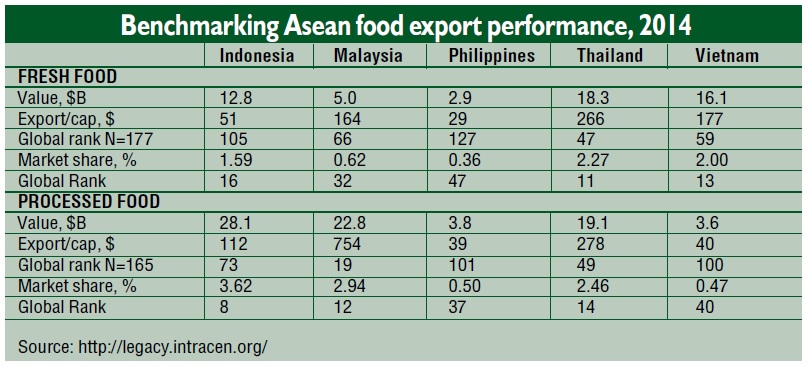Benchmarking Asean food exporters
HOW DOES the Philippines compare with its Asean counterparts in food exports?
In 2014 (the latest data), the country exported a total of $6.7 billion as compared to Indonesia’s $40.9 billion, Malaysia’s $27.8 billion, Thailand’s $37.4 billion and Vietnam’s $19.7 billion. These amounts exclude natural rubber products, which are nonfood but also significant exports.
Food exports have two categories: Fresh and processed.
Fresh food
Thailand exported $18.3 billion in 2014, followed by Vietnam $16.1 billion and Indonesia $12.8 billion. Malaysia was 4th at $5 billion, and the Philippines last $2.9 billion.
In terms of per capita export rank, Thailand is 47th, Vietnam 59th, Malaysia 66th, Indonesia 105th, and the Philippines, 127th out of 177 countries.
In global market share, Thailand was 11th, followed by Vietnam 13th, and Indonesia 16th. The Philippines was 47th.
Processed food
Indonesia exported $28.1B in 2014, followed by Malaysia $22.8 billion and Thailand $19.1 billion. The Philippines surpassed Vietnam by a slim margin: $3.8 billion versus $3.6 billion.
By export per capita, Malaysia led by a mile at 19th among 165 countries, followed by Thailand at 49th. Tail-enders were Vietnam at 100th and the Philippines at 101th.
By global market shares, Indonesia was 8th, Malaysia 12th and Thailand 14th. The Philippines was 37th and Vietnam 40th.
Exports expand markets and, therefore, increase farm incomes and jobs. Competition provides the discipline of scale, quality and reliability.
Some 50 percent of the production of Thai food processing industries are exported, according to a key source. In the Philippines, which has a low processed food exports of $3.8 billion, the share of food processing in the gross domestic product is about 10 percent, or $28 billion. This means that less than 15 percent of the Philippine food processing output is exported.
What needs to be done for the cellar-dwelling performance of the Philippines? The remedies have been advocated by experts for a long-time. Productive and diversified agriculture.
Productive agriculture
First, improve rural technical services to increase lagging farm productivity. This is a major national concern, but ground execution is done by the local governments. The management structure needs revisiting.
Except for Cavendish banana and pineapple (both export crops), most farm yields are below Asean peers. The high yields allow scale as a reliable supplier. Low yield is the reverse. For other crops, high yields provide scale for food manufacturing.
Diversified agriculture
Second, diversify agriculture from the traditional base of rice, corn and coconut. Inter-cropping of about one million hectares of coconut lands is a good option. Planting cacao will increase exports of beans, and drive value-added processing.
For instance, the food processing industry in Malaysia used $71 billion worth of raw materials. Domestic raw materials provided 88 percent while imported raw materials, 12 percent, according to the Malaysia Department of Statistics as quoted by USDA GAIN Report, 2015.
Selling of Lands
Third, allow selling of lands already distributed under agrarian reform so that entrepreneurs can consolidate to achieve scale and productivity. Efficient farmers can buy and lease lands while the inefficient ones can move out of farming. Not everyone can be productive in any profession, much more so in farming. While land is an emotional issue, there are vast under-utilized lands untapped.
The performance gap of the Philippines with peers in terms of food exports is so wide. Will the Philippines still be able to catch up?
(The article reflects the personal opinion of the author and does not reflect the official stand of the Management Association of the Philippines or MAP. The author is the Vice Chair of the MAP AgriBusiness and Countryside Development Committee, and the Executive Director of the Center for Food and AgriBusiness of the University of Asia & the Pacific. Feedback at <map@map.org.ph> and <rdyster@gmail.com>. For previous articles, please visit )

